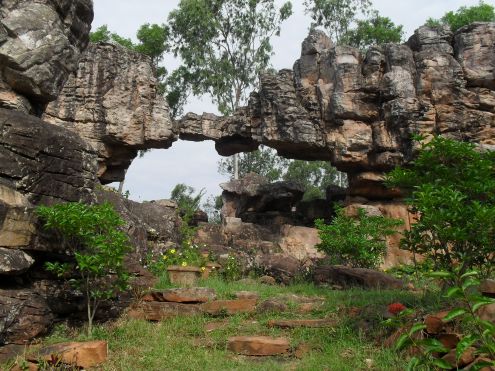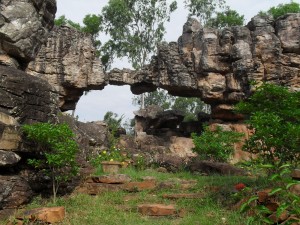From the Wikipedia page for “Natural Arch, Tirumala hills:”
Natural Arch, Tirumala hills is a distinctive geological wonder located 1 kilometer (0.6 miles) north of the Tirumala hills temple, near the Chakra Teertham in the state of Andhra Pradesh, India. The Arch is also called Silathoranam in local language (Telugu language: “Sila” means ‘rock’ and “thoranam” means a garland strung over a threshold, connecting two vertical columns or an ‘arch’ as in this case). The arch measures 8 meters (26.2 feet) in width and 3 meters (9.8 feet) in height, and is naturally formed in the quartzites of Cuddapah Supergroup of Middle to Upper Proterozoic (1600 to 570 Ma) due to natural erosive forces.
Mythological folklore related to the arch, linked to the famous Tirumala hills temple of Lord Venkateswara, has three versions:
1) According to one version, the arch resembles the hood of a serpent, a conch (Sanskrit: Shank) and a discus (Sanskrit: chakra) – all symbols of worship in Hindu religion – and considered to be the source of the Idol of Lord Venkateswara or Lord Balaji at the Tirumala hill temple;
2) The second version is that the main deity in the Tirumala temple is of the same height as the height of the arch;
3) The third version is that Lord Vishnu (Hindu God) called as Balaji or Venkateswara (the Central deity of Srivaishnava tradition) at the Tirumala temple town, is supposed to have put his first foot down at a place called Padalu or Sreevaripadalu (Telugu language: Divine foot prints) which is the highest point of Tirumala hills, the second step at the location of the arch. Thereafter, the next step is stated to have been placed where his idol is now worshipped in the temple at Tirumala.
[For a larger, more detailed, version of the photograph above, click on the image below.]




0 responses so far ↓
There are no comments yet...Kick things off by filling out the form below.
Leave a Comment